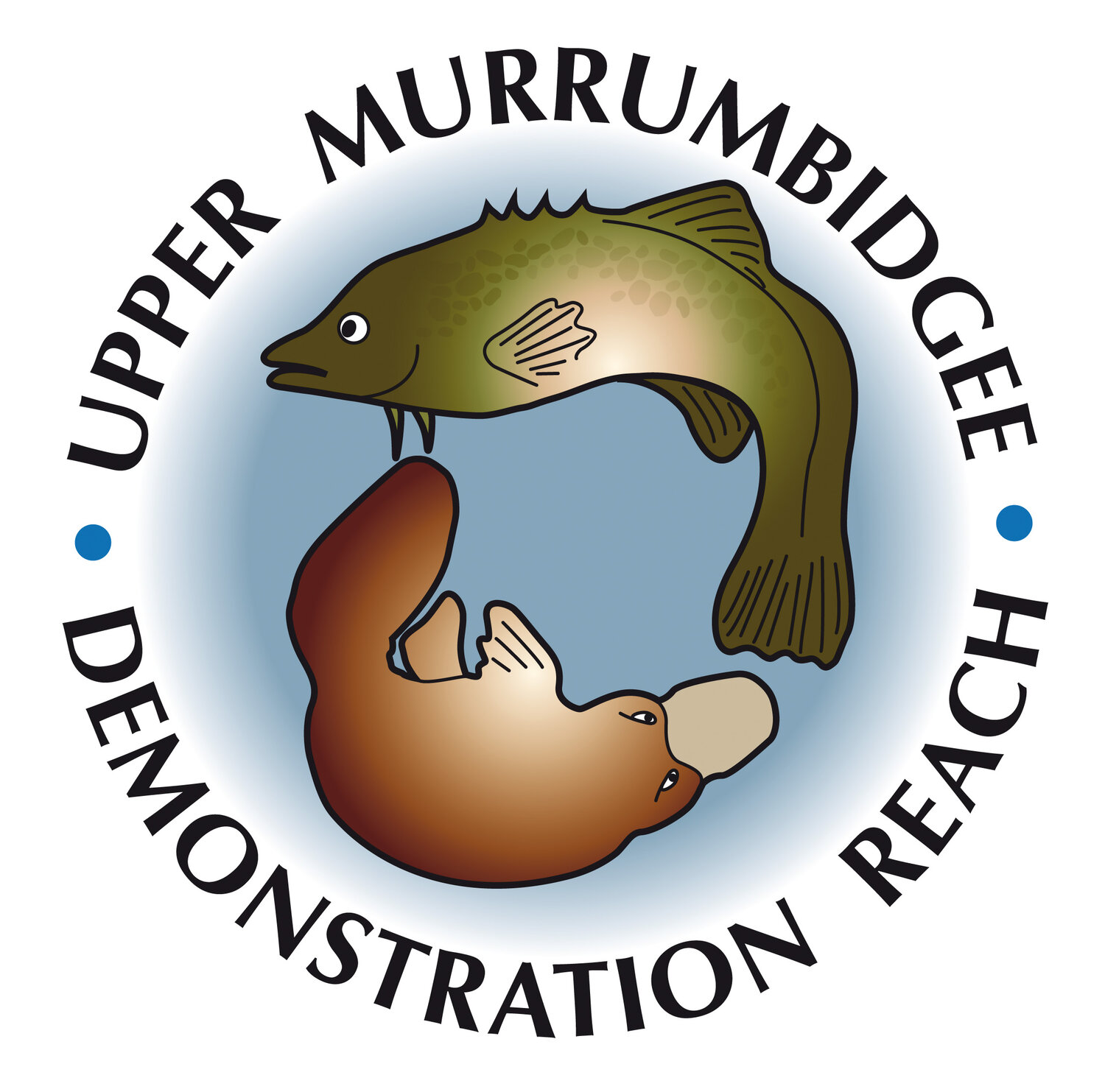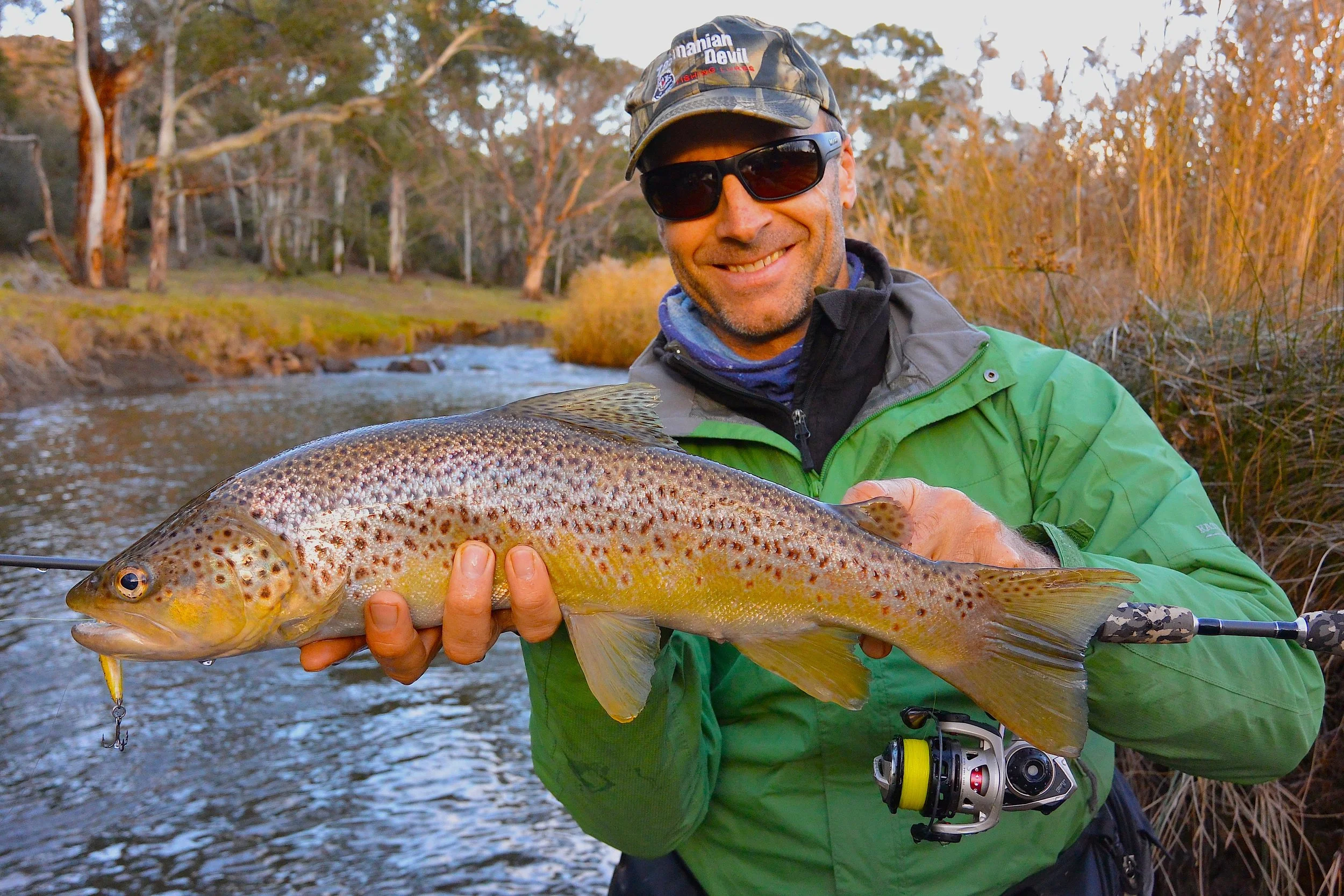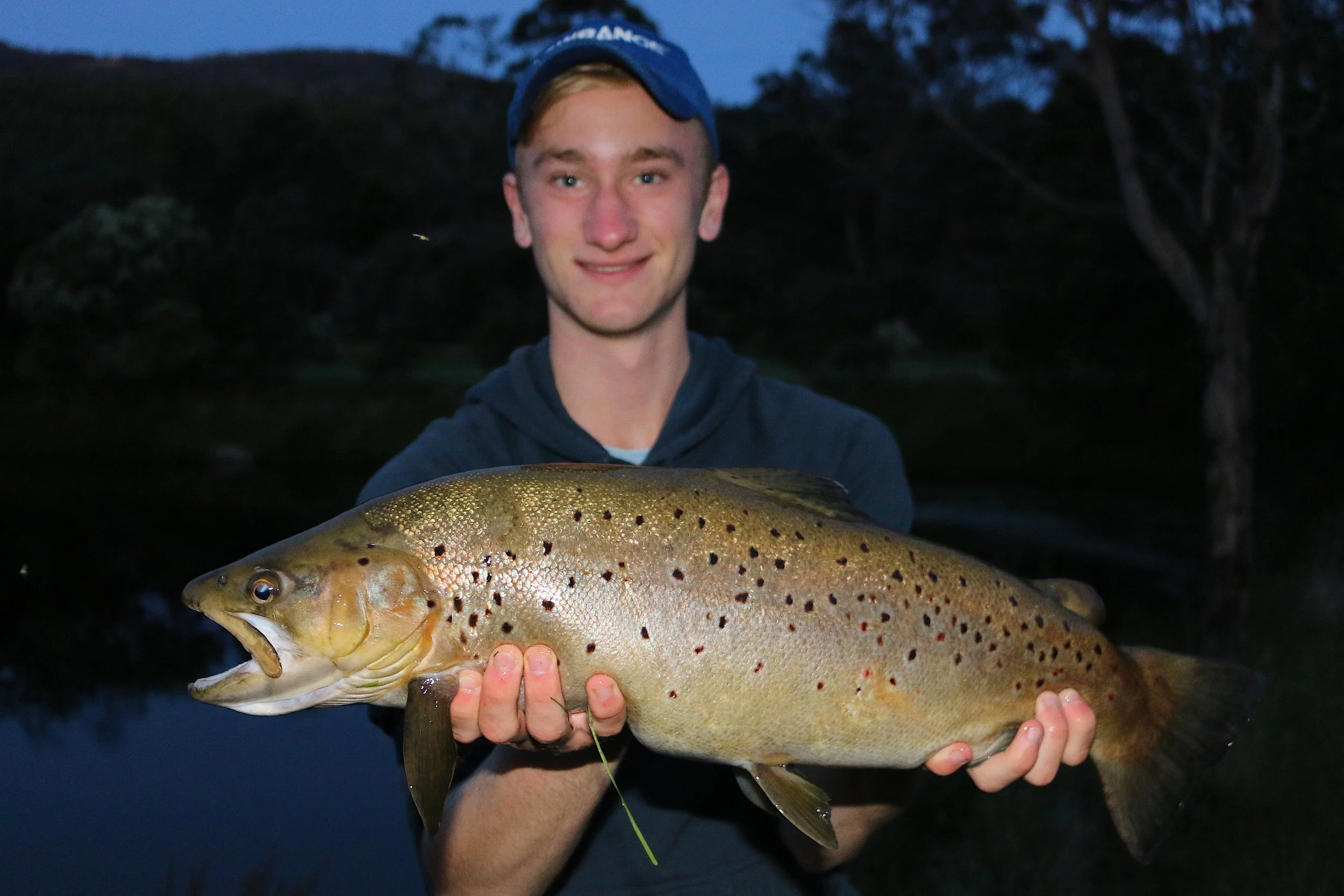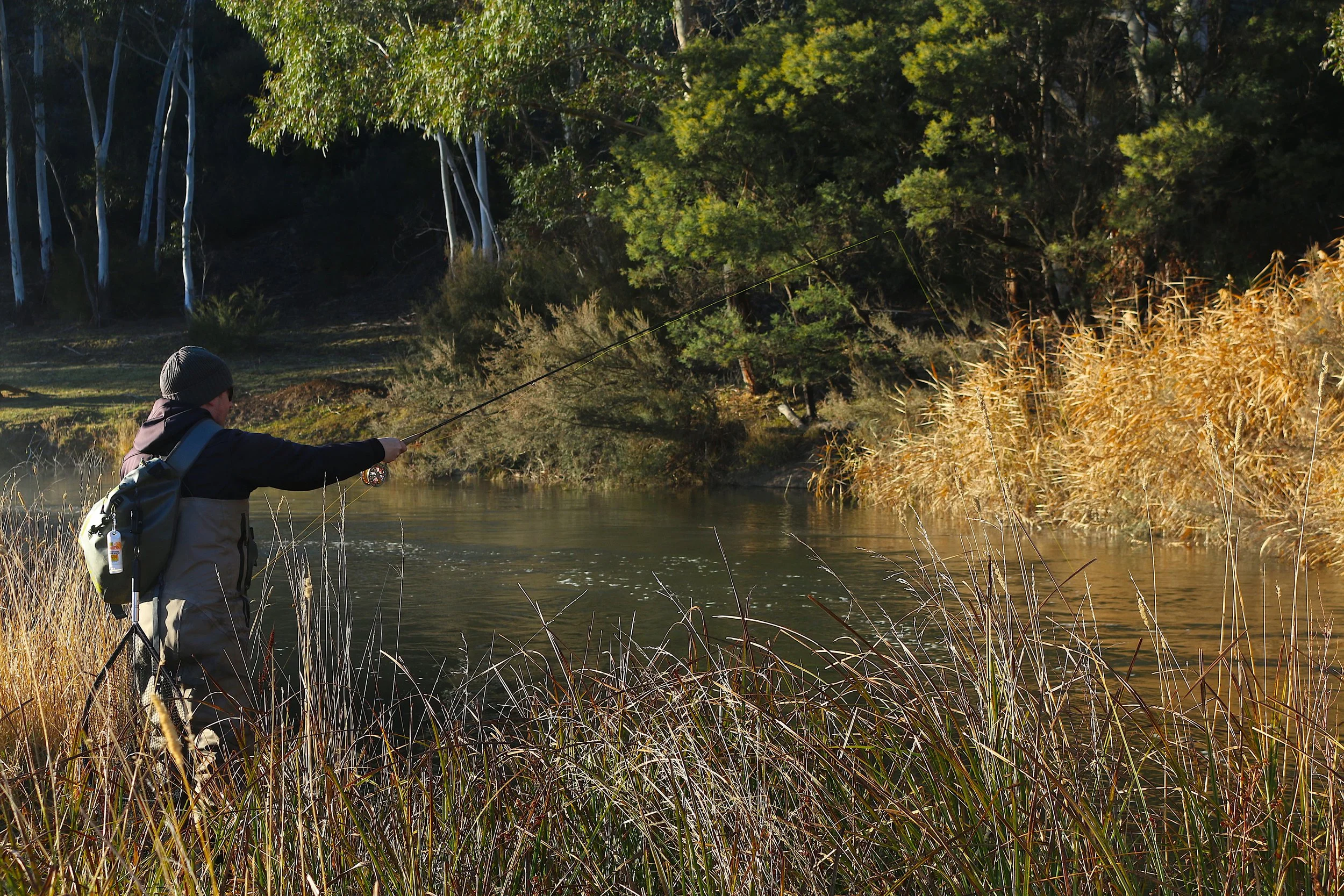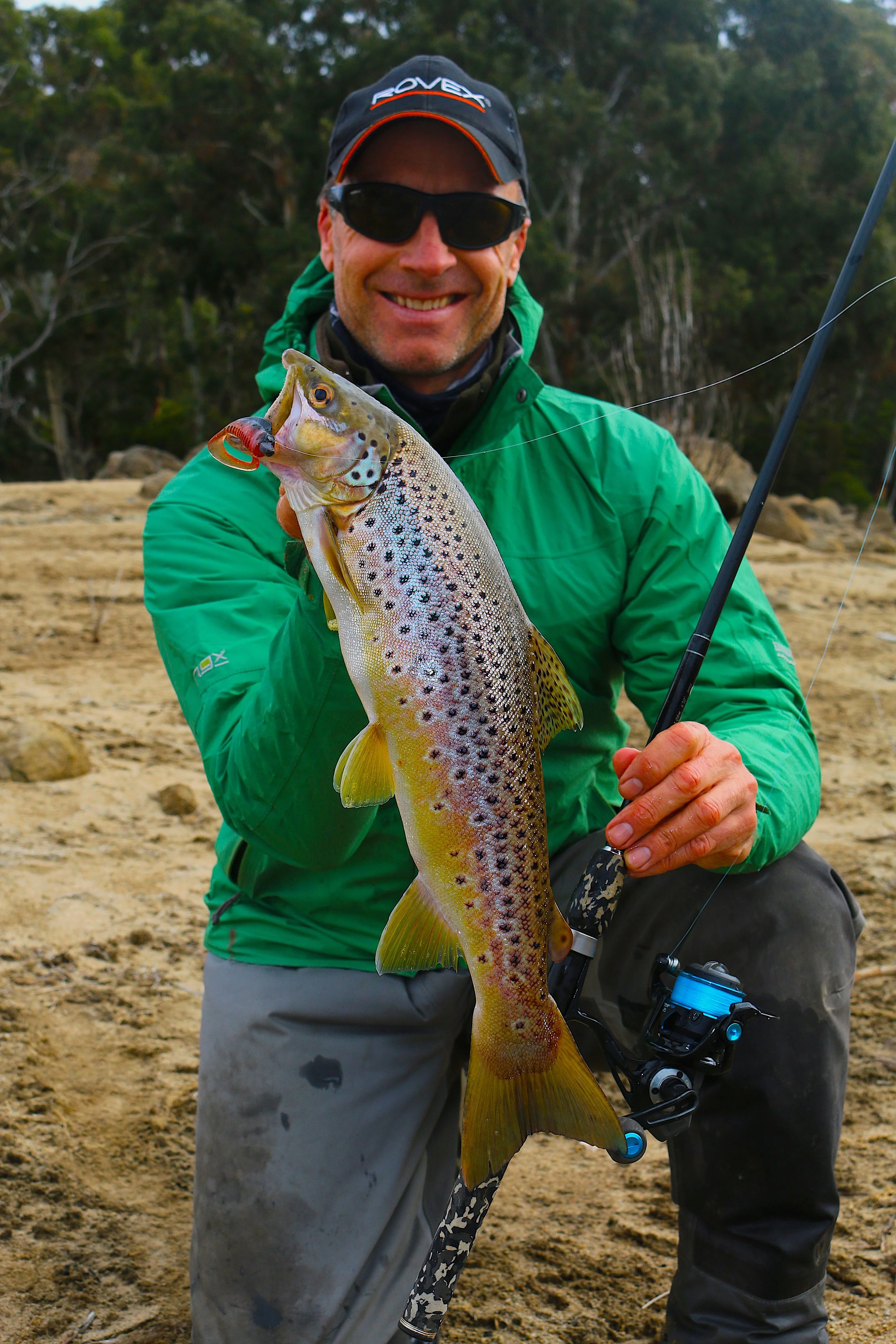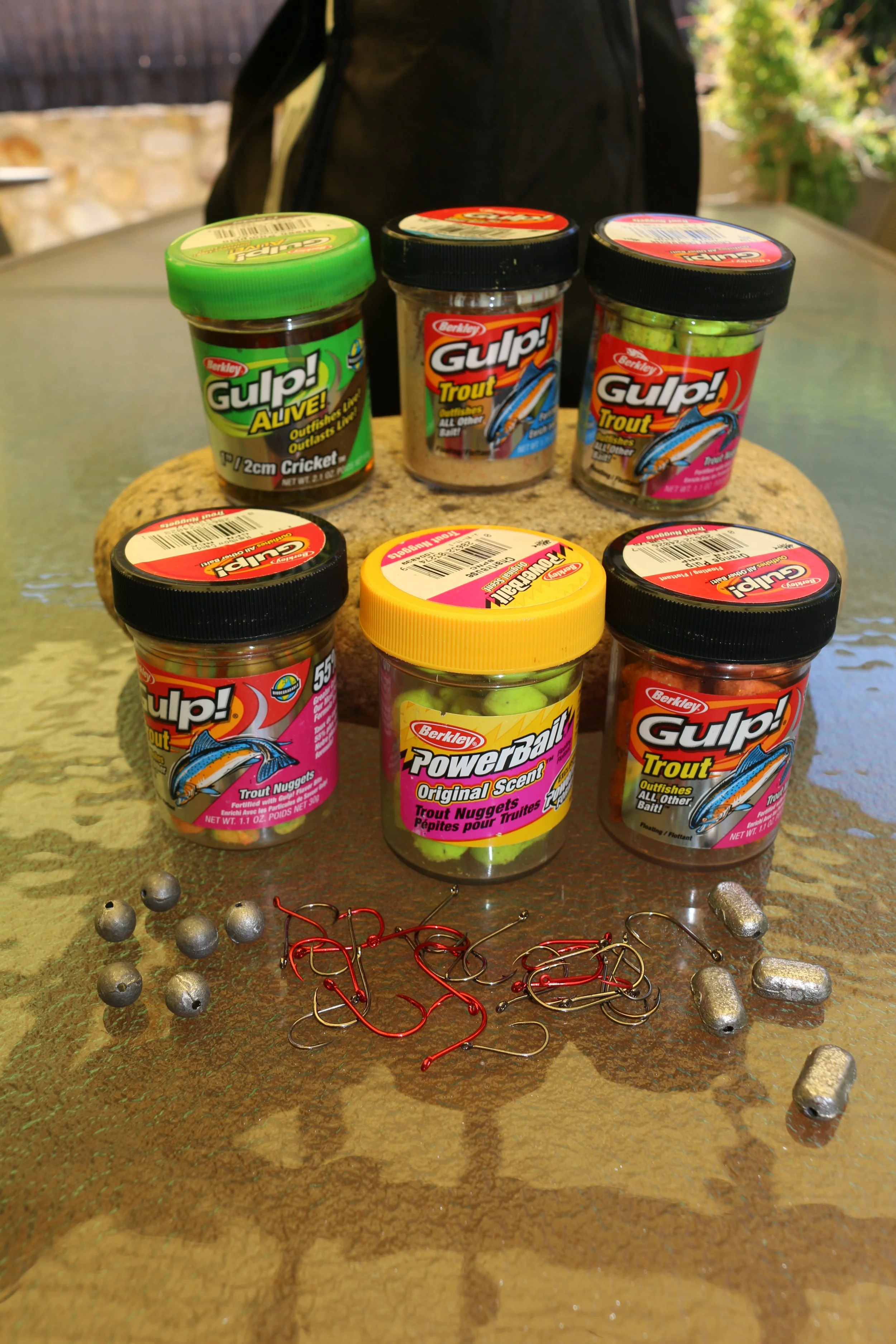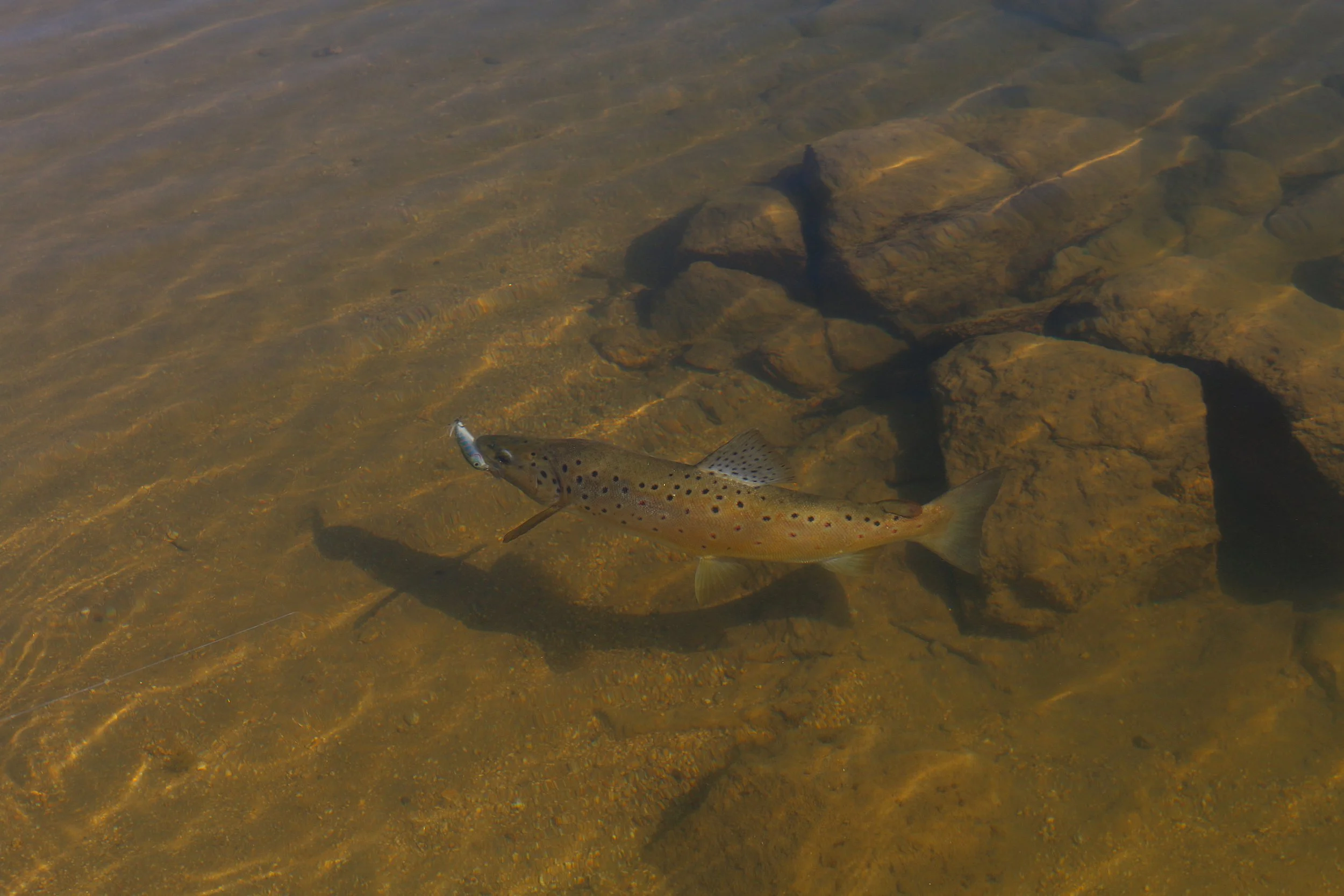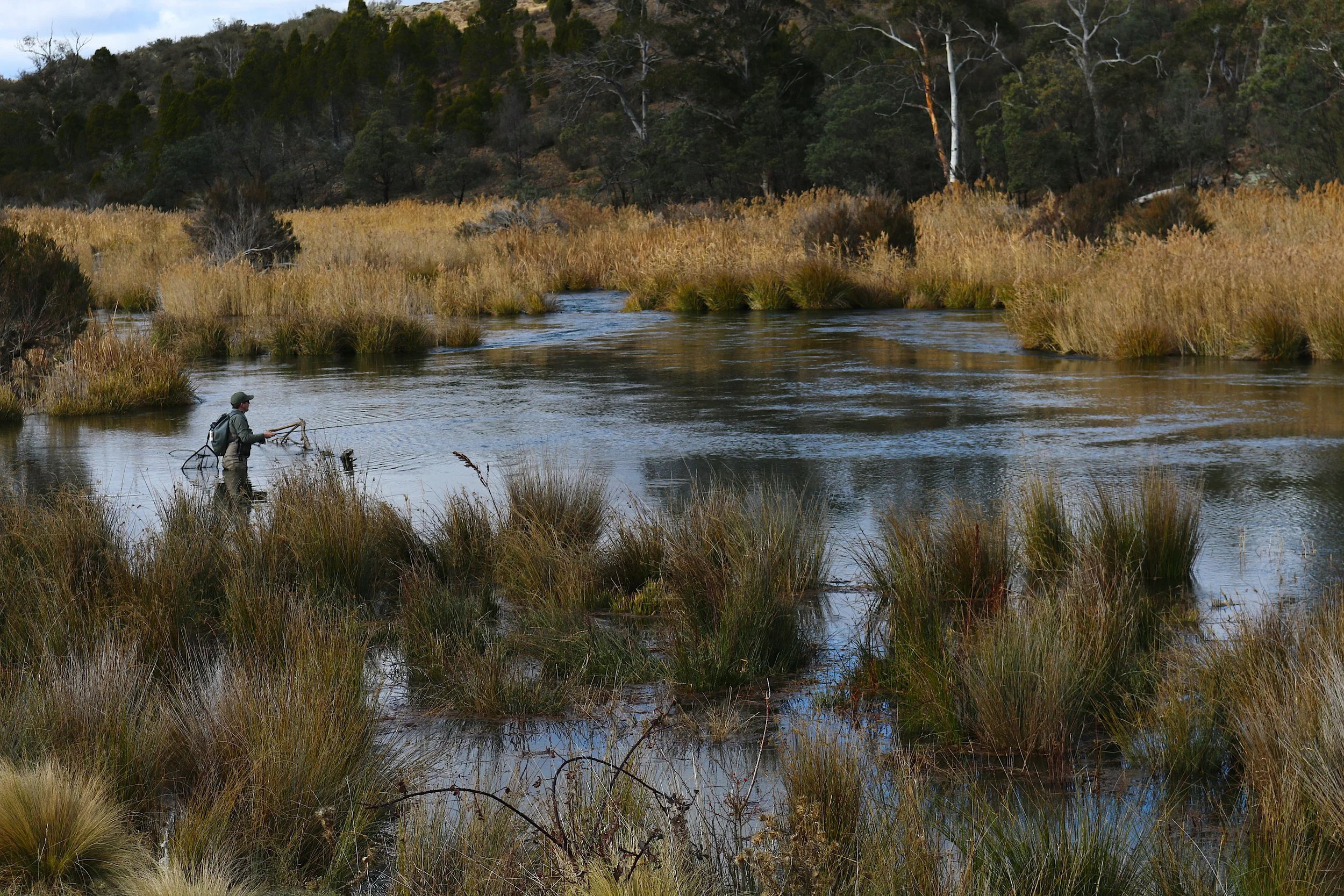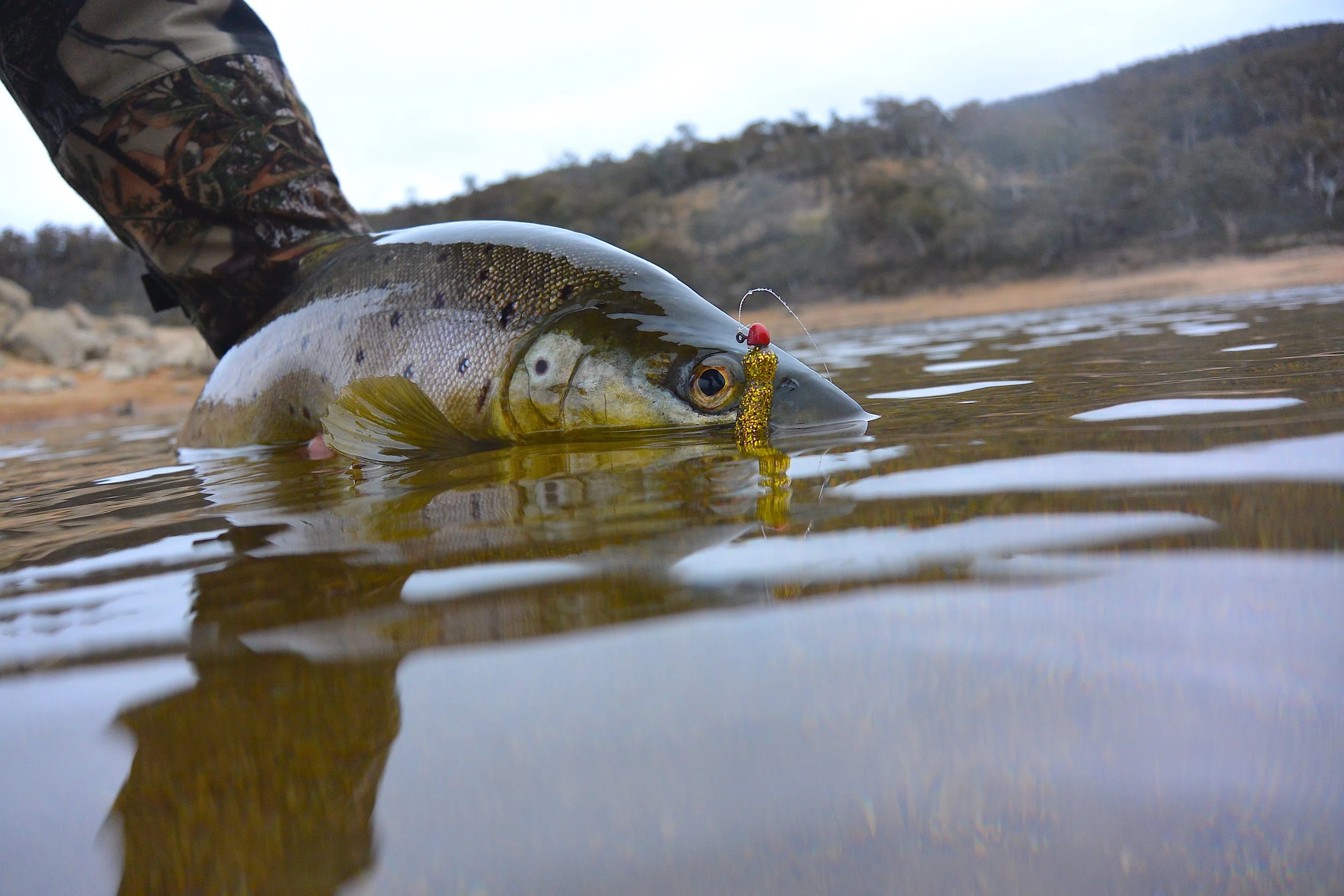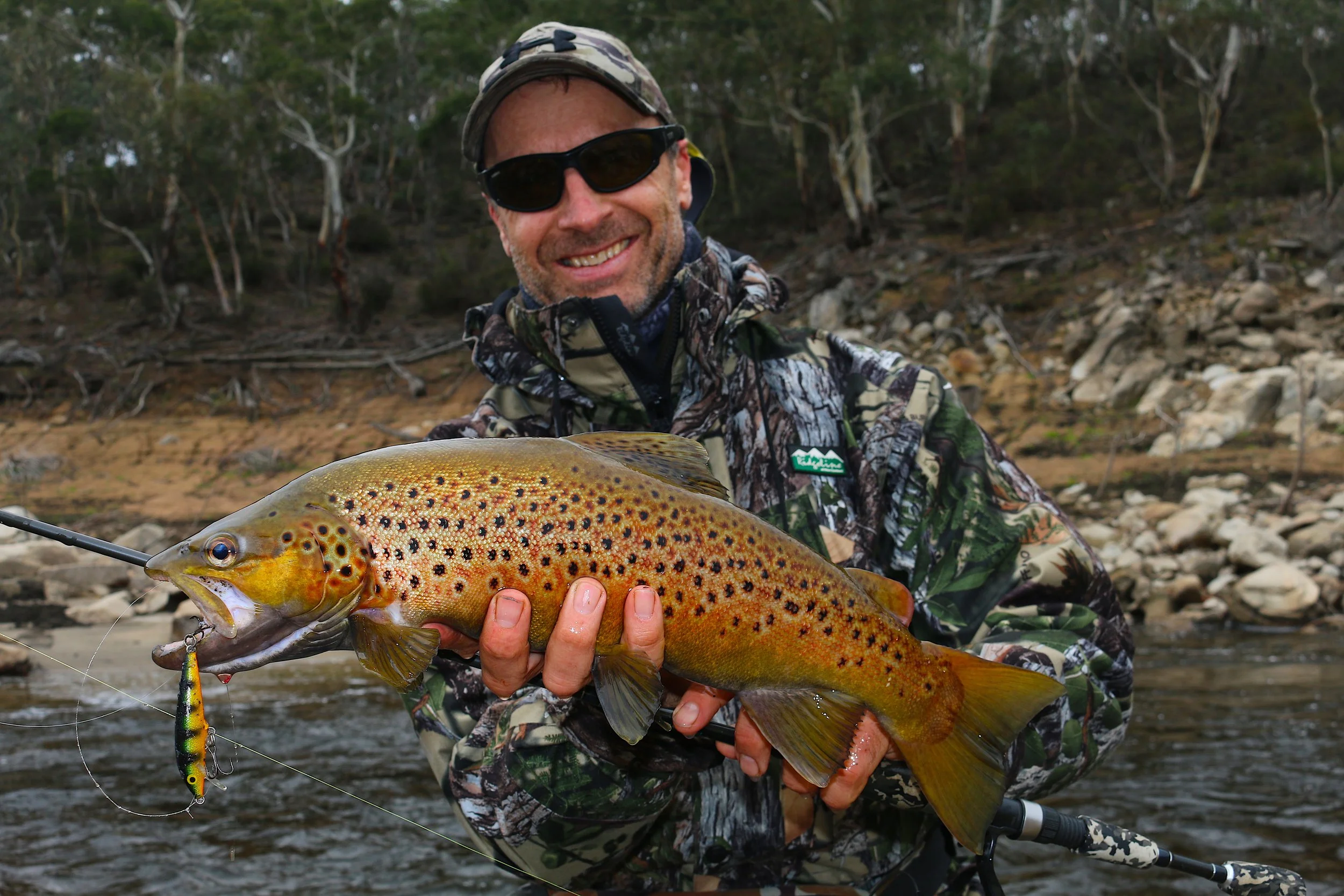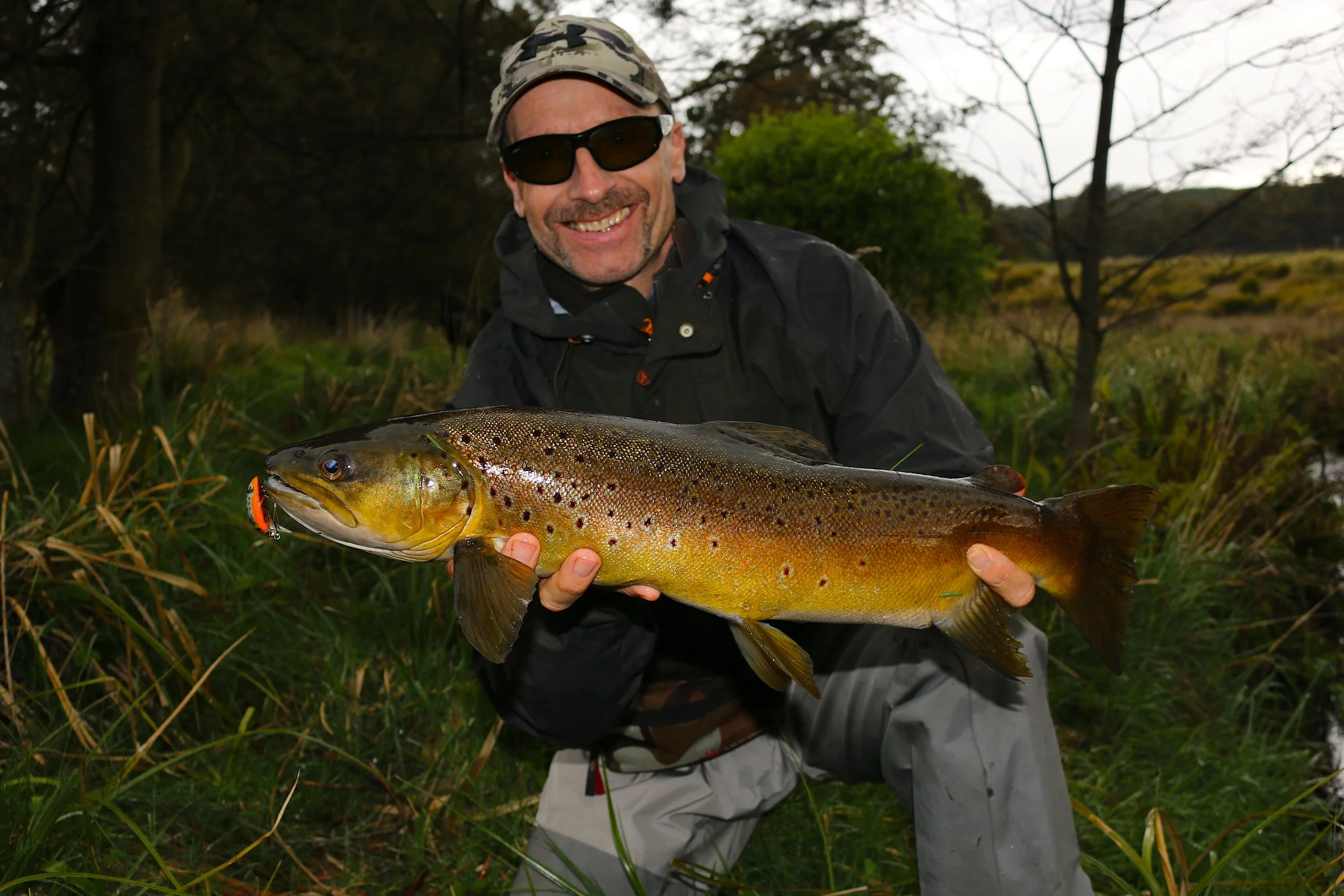Brown Trout (Salmo Trutta).
Brown trout were introduced into Australia in the 1864 from the United Kingdom and are a world renown freshwater game fish. They are native to Europe and are regarded as a prized catch by all manner of anglers. Like rainbow trout, brown trout thrive in cool, high-country rivers, streams, and creeks, particularly those with consistent well oxygenated water. They are abundant and thrive in many lakes and reservoirs across NSW, the ACT, Victoria, South Australia, Tasmania, and South Western WA.
Brown trout are now self-sustaining in numerous waterways, however stocking by Fisheries departments and local fishing clubs continues in many areas. Stocking has ceased in some water catchment zones due to the serious impact brown trout have had on a number of threatened native fish, particularly Macquarie perch, River Blackfish and galaxiid species. As well as being a popular and highly regarded sport fish by lure and fly fishers, they are also a much sort after table fish, and an important recreational species.
A mammoth brown trout.
Where to Fish
Brown trout can be found and caught is a wide range of high-country rivers, streams, and lakes. They prefer cool, temperate waterways and at times can be a highly aggressive species often preying on small fish.
In rivers, streams, and creeks, where brown trout are present, they will hold in the prime “lies” in that stretch of water. Boulders, sunken trees, and slight bends in the river that divert water and provide protection from the current are ideal locations to cast lures and flies. Small back eddies in larger pools and areas adjacent to rapids and running water will also attract active feeding trout. Overhanging bankside shrubs and any other forms of flora are further favoured places to find big brown trout waiting for any food item that may fall out of the vegetation
In reservoirs, lakes, and other open bodies of water clusters of rocks, large bays, and partly submerged tree-lines are areas worth concentrating your lure and bait fishing efforts. These features of a lake will be home to underwater beetles, a variety of crustaceans, snails, as well providing sanctuary for small, foraging fish. Mud beds are another highly productive area due to their yabbie population. These protein rich morsels are high on the list of favourite food items for predatory brown trout.
A mammoth brown trout caught on a XX lure in a Snowy Mountains reservoir.
Size
In rivers and streams fish average between 25cm to 50cm. Lake fish are often slight larger and carry more weight for their length due to the abundance of food and less taxing environment they live in. A brown trout of 65cm or greater is a trophy capture, however, there have been some genuine giant brown trout caught over the past couple of decades in our high-country lakes. A 70cm fish (or 10lbs in the old scale) is considered a fish of a lifetime which many recreational anglers spend countless years pursuing.
Lake fish are often slight larger and carry more weight for their length due to the abundance of food and less taxing environment they live in.
Bag, Size Limit and Closed Season in NSW/ACT
It is important to remember that trout seasons observe a closed and open season. Please consult the relevant fishing guides for the state.
NSW Southern Trout Fishing Guide
NSW Northern Trout Fishing Guide
NSW Central Trout Fishing Guide
By-Catch
Depending on which area you are fishing there is a chance you may hook Macquarie perch, River Blackfish, and even Trout Cod when targeting Rainbow Trout. Remember all three species are totally protected (in NSW, VIC and the ACT) and should be released unharmed, as quickly as possible. If you are unsure of the identity of the species it is best to release it unharmed without removing it from the water.
If you are land-based fishing and happen to hook one of the protected species, it is important you do not drag or pull these species onto the mud, sand, and dry grass as this will damage the protective slime covering their body. Removing this protective slime will leave the fish susceptible to infection and bacterial growth once released back into the water. Leave the fish in the shallow water by the edge and remove the hooks while the fish is in the water. A fishing glove or wet towel can assist in subduing the fish while you remove the hooks.
Artificial baits such as Berkley PowerBait are an effective bait for brown trout.
Lure and Fly Fishing
Brown trout are considered the most aggressive, introduced species in our southern waterways. This characteristic coupled with their predatory nature make them the perfect target for lure and fly anglers. Below is a breakdown of the different groups of lures and flies which have been successful for decades in Australia.
Spinnerbaits
Spinners have been around since the 1960s and are one of the most popular all round trout lures. Compared to other lures they are cheap, simple to use, and highly affective on aggressive trout in both streams and around the shallow margins of lakes. The rotating blade on the central wire shaft of the lure, sends out flashes of light that combine with an enticing vibration to make it difficult for both brown and rainbows to resist. A slow, methodical retrieve is often the best but it is always worth altering the speed of each retrieve to generate interest from a wily brown. A slightly faster than walking pace retrieve will tap into the predatory natural of a cautious brown trout.
Diving Minnows (Hard Bodies)
Possibly the most successful lure of the last half century to target trophy brown trout. Shallow running minnows in natural colours are by far the best style of minnow to use. These lures imitate small fish which brown trout prey on. Brown trout are carnivorous cannibals who will gladly eat their own. For this reason, trout pattern minnows are a mainstay in a lure fishers tackle box with the ever-reliable “Spotted Dog” pattern being the top of the list. Minnows should be between 50mm to 90mm in length but don’t be afraid to try lures as long as 180mm, as monster browns have been found to have blackfish, goldfish, and other trout as long as 250mm in their stomachs. A diving depth of under one metre is preferred for most lure casting scenarios. Use erratic retrieves, vary speed frequently, and impart plenty of flicks and jerks, with your rod tip, to best replicate an injured small fish.
Winged Lures
The most popular winged lure is the Tasmanian Devil and is a mainstay of anglers who troll for trout. The tantalising side to side swaying action of winged lures is highly attractive to all trout species. Trolling lures by following the contours of the shoreline is the most popular method to catch trout. Winged lures can also be cast from the shore or a kayak with great success. Look to cast and retrieve winged lure over mud beds and across large, sweeping bays to hook any browns in the areas.
Soft Plastics
The life like appearance, realistic feel when a fish bites, and the variety of soft plastic style lures has become the modern way to target brown trout with lures. Small fish imitations such as minnows and jerk-baits worked through various depths in the water column of both rivers and lakes is a proven method. Dark, natural colours, as well as trout replicas, work well. On clear, calm days it can pay to try bright colours such as orange, pink or red plastic bodies. Browns are also susceptible to crustacean and grub imitations when fishing in and around rocks or muddy banks.
Fly fishing can be an effective and rewarding means of catching Brown Trout. In most river, stream and lake scenarios, a 6-weight outfit with a floating line is an ideal general purpose set up.
Tackle
A 1.6m to 2.2m rod matched with a 3000-4000 sized threadline reel spooled with 8-14lb main line is ideal for bait fishing. A similar outfit can double as a spinning outfit, however, reducing the breaking strain of your main line to between 6lb and 10lb will facilitate smooth, seamless casting with light lures all day long.
If flyfishing is your preferred technique or if you are a beginner, then for most river, stream and lake scenarios a 6-weight outfit with a floating line is an ideal general purpose set up. Black, brown, and olive coloured Woolly Buggers are the most reliable fly available. Buggers are perfect for working the edges of lakes and rivers.
Rivers and streams where boulders, sunken trees, and slight bends in the river that divert water and provide protection from the current are ideal locations to cast lures, flies and fly fish.
If you plan on releasing your catch, leave the fish in shallow water and remove the hooks while the fish is in the water. This will ensure that you do not damage the protective slime on their bodies. This same method should be employed if a protected species is caught.
Fishing Tip
Once brown trout reach around 25 to 35cm long, they progressively become more piscivorous and in some areas will almost solely prey on small fish. This includes other trout as well as vulnerable small bodied native fish. As well as the propensity to feed on small fish, during pre-spawning periods brown trout become highly aggressive, especially towards other trout. These factors mean that lures that imitate a small trout are extremely effective when targeting brown trout. Shallow running hard bodied minnows and soft plastic minnow bodies in brown, rainbow, and brook trout patterns are hugely popular for anglers searching for those bigger than average trout. Erratic retrieves worked in and around structure in rivers or across shallow bays or shorelines of lakes will produce quality trout. Dawn and dusk are often the best times to catch those bigger, smarter fish as they can hunt under the cloak of low light conditions.
Help Our Fisheries and Waterways
While undertaking recreational fishing activities you may come across various species of fish. Some streams such as those in the the upper Murrumbidgee catchment upstream of the ACT do not contain species such as Redfin. You can help fish scientists and fisheries managers to protect these species and maintain fishing grounds through logging fish sightings on Feral Fish Scan.
Download the Feral Fish Scan app.
In rivers and streams brown trouth average between 25cm to 50cm.
Once brown trout reach around 25cm to 35cm, they become more piscivorous and in some areas will prey almost soley on small fish. Due to this, lures that imitate small trout can be very effective when targeting brown trout.
Does this sound important?
If you are inspired by our work and our focus, learn about how to practically support this work.
